Starlight X-2 is a puzzle game released on Google Play and iOS in June 2020. Six months after release, it’s a good time to evaluate the success or failure of this project.
For those interested by the big picture, here is a simple visual summary of the expenses and revenue of the game:
With Frozax Games, I’ve specialized in puzzle mobile games (even though I just released an hypercasual game last month: 3 Seconds). Starlight X-2 is my 8th mobile game, and 7th puzzle game. It’s based on lighting, space and planets.
The development of the game lasted about 6-8 months, between November 2019 and June 2020. I quickly got a working prototype in the end of December. After a few tests with friends and family, I realized the game was interesting and promising, but quite difficult to understand. After a lot of time spent iterating on the tutorial, I found an artist and we worked together during the first lockdown in France (from March 2020). The game was released in mid-June 2020 on Google Play and iOS. It has only 9970 downloads on Google Play and 920 on iTunes.
Expenses
- Art: €1200. This was a low price because of my relationship with the artist.
- Translations/Proof-reading: €1600. The game is translated in 16 languages. Also, there are much more texts than in my usual games because of features such as “Did You Know” that gives fun facts about space to the players.
- Advertising (Facebook): €2100. That’s quite a lot. And once again (see my previous experiences on UA), it was really not worth it. Acquiring players through advertising with a puzzle game seems difficult, or at least I don’t know how to do it (see below for details).
- ASO: €630 ($750) I hired a company to improve ASO in August. Without much surprise, I didn’t see any change or improvement at all…
Total: 5530 €. Of course, I didn’t count my time developing, designing and releasing the game here, just external charges.
Revenue
The business model of the game is quite classic:
- Free download
- There are sometimes interstitial video ads at the end of levels.
- You can unlock new levels or get more hints by using rewarded video ads.
- You can purchases packs ($1), hints ($1 or $2) and remove interstitials ($1).
- You can subscribe to get everything for free (weekly: $2, monthly: $5 or semi-annually: $20)
As seen on the first image of this post, most of the revenue comes from ads: €1852, then in-app purchases brought €423 and subscriptions, €279. You can also see the split by in-app type, and by subscription duration.
Split per platform
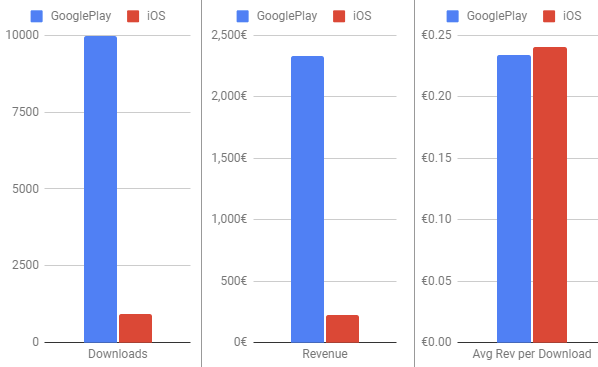
Split per country
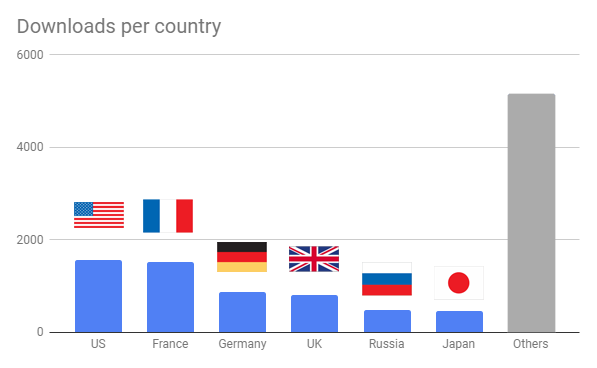
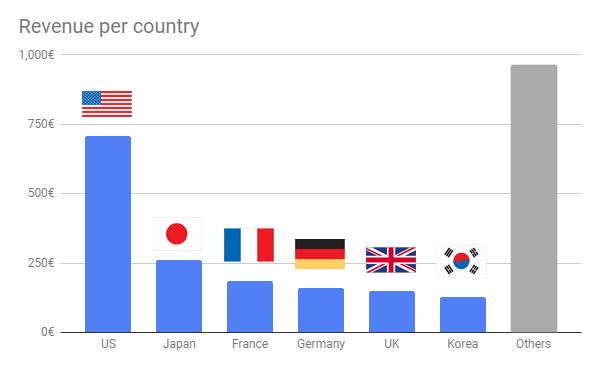
Ad campaign
As usual, I found that the most difficult is getting downloads. Finally, with the small download numbers, the revenue are not that bad (€0.23 per download).
The chart/table below show the summary of my ads campaign (“de”, “fr” and “en” is the targeted language of each ad).
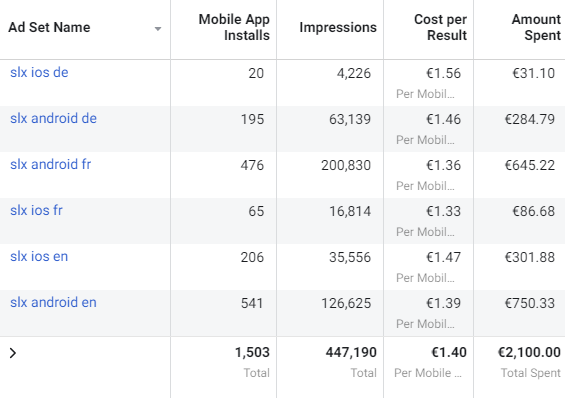
As you can see, I couldn’t make profitable user acquisition. CPI is really high, and the engagement of acquired users was terrible compared to organic. Even though I gathered a lot of useful information and experience, acquisition was again a failure [if you know how I can get better, contact me!].
ASO
The ASO was basically money wasted. Once again, except for the experience. Now that I think about it, I didn’t hear from the company for a long time… Are there really efficient and serious ASO companies? If you know some or work in this field, please contact me as well!
Conclusion
For now, the game is still not profitable and download numbers are still too low these days.
I think I should have released the game earlier, with fewer features. I especially think of the feature “Did you Know?”. The game displays various facts about planets and stars and the end of levels. While this is a great feature in my opinion, it might have been a better idea to cut this feature for the initial release. It took a lot of time to design and generated a lot of texts to localize (and increased the localization overall cost), and it’s not the core gameplay. I could add this feature later, when/if seeing interest for the game.
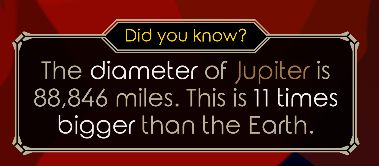
The game itself is also quite complex. I honestly still think that it’s one of my most interesting puzzle game. But even myself, if I’m not in the mood thinking too much, I find it hard. I’m sure there’s an audience for this kind of games, though.
Hope you liked seeing these numbers. Feel free to contact me on any social network (Twitter, now on Discord, too) and comment here if you have any questions about this article or anything else!
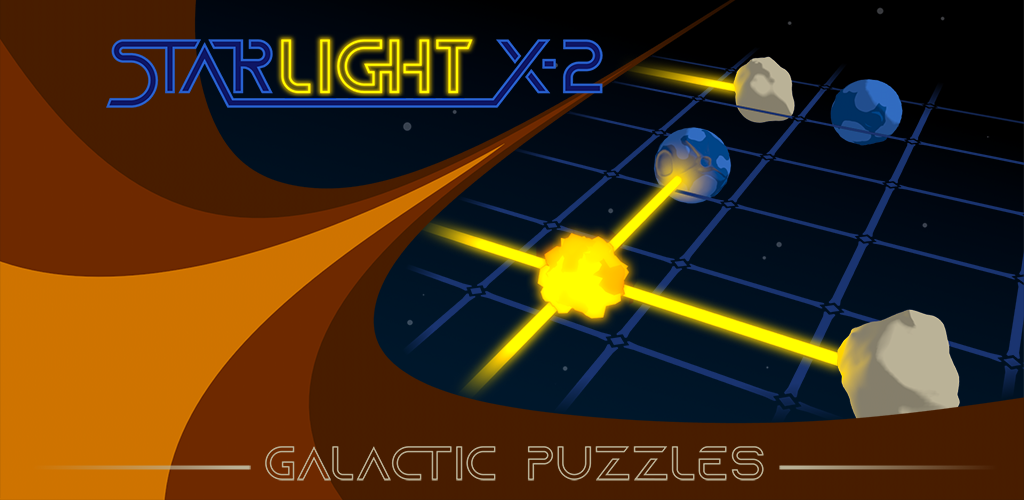
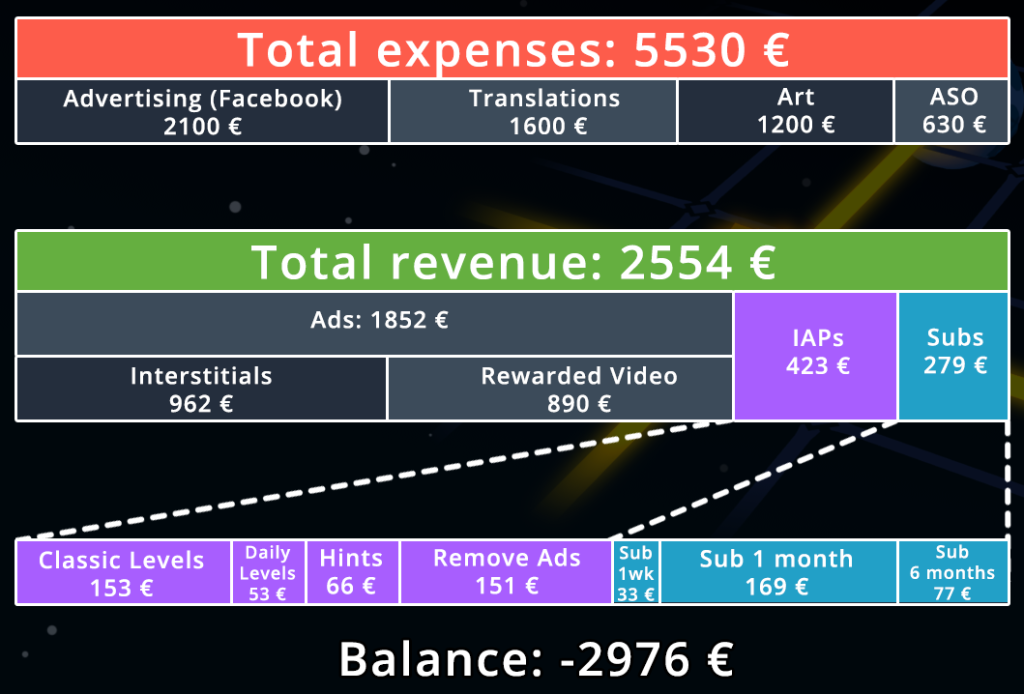
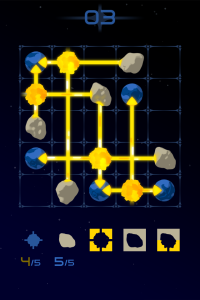
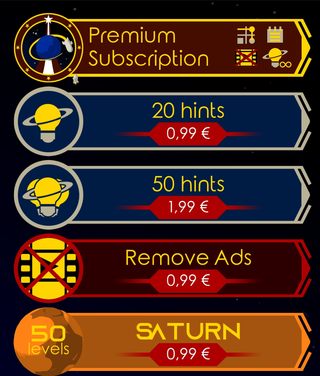
First of all, thank you for sharing openly these numbers. It helps us to get a better picture of the market.
I don’t know what’s the paid vs organic traffic you get, but assuming most of the numbers were generated by the paid traffic, the overall picture is positive. If we ignore one-time costs, you spent 2100 € on ads to generate 2500 € revenue. Is that also your view?
I agree with your insight about holding off with “interesting facts” feature. As cool and interesting as it is, it generated large cost upfront.
But there’s a bigger and related thing that wonders me: what was the reason you decided to translate to 16 languages right from the beginning?
My view (based only on views of others so far 🙂 ) is that the process of making F2P game profitable is about iterations:
1) Buy a steady stream of players from cheap locations, in order to get meaningful data over time for your analytics
2) Analyse your data and try to find spots to decrease churn / increase retention / do something better. Doing better also means AB tests of your store page and ads in order to increase conversion rate which will decrease acquisition cost
3) Deploy new version, compare and repeat
My point is, I think you might have gotten more by focusing on being profitable on one market (language) first and only afterwards investing more resources (e.g. time and money for translations) into other markets. This is more true if you plan to actively change your game, which will require new translations.
What do you think?
Thanks for your comment,
About paid/organic traffic, my view is completely different, actually. While I indeed spent 2100€ to generate 2500€, when I look carefully at the retention of paid vs organic players, I think it that without ad, I would have paid 0€ to generate 2450€ 🙂 There might be organic downloads coming thanks to paid downloads (the “k-factor”) but I don’t think it’s really that high.
About translation, I’ve been used to translate my games and seeing that my revenue from other games comes from all over the world, then why not doing it again? Also, it’s much easier to translate to all languages at once instead of translating to 5, then 5 other, and 5 other. I thought it could also help because I could market the game worldwide and maybe get better rankings thanks to that. (see below: I changed my mind)
I also added the “did you know?” feature thinking I could use it as a USP (Unique Selling Point). However, seeing how bad I am at marketing, it probably didn’t have any impact 🙂
About analytics, I find it really hard to get enough players to have meaningful statistics and reliable numbers (countries are really different (how to compare France, Russia, Brazil and US in terms of CPI/eCPM/retention?), what about “instant play games” players? different sources gives me different numbers, how to have precise retention with only a few dozens new players per day…). Of course, I still spend a lot of time on analytics.
However, I learnt a lot from Starlight. I basically came to the same conclusions as you did. For my latest release “3 Seconds”, I’m working like that:
– I released a more basic version in French/English (all by myself)
– I spent ad money (with cheaper CPI than Starlight)
– I analyzed the retention and ARPDAU.
– I added features to try improve it
– Once I consider I added almost all useful feature, added 8 (not 14) translations
– Spending more ad money on different (and sometimes cheaper) countries
– Waiting to get more data to analyze again
I still consider Starlight a failure for now, at least the first 6-month are a failure. But things could change and it can be profitable in the long term.
Don’t want to argue with your data, but have to ask if you compared organic and paid traffic at different time periods or the same? I noticed an interesting behaviour when doing one of my free marketing campaigns.
I posted riddles (like this one https://twitter.com/MeekBits/status/1286204060371234816) to 15 brain puzzle groups on Facebook for around a month.
The results were not worth the effort, but the important part is that the posts’ text and graphic had bit.ly links.
Halfway through the experiment, I was observing 30-50 store page visitors per day.
At the same time, the bit.ly link had around 2-3 clicks per day.
So I thought: it’s actually Google that brings these users, not me.
Then I stopped posting in the aforementioned groups and the store visitors dropped to 3-5 per day 🙂
Even though the numbers are not big, they were surprisingly steady.
I learnt I could only judge the campaign’s effectiveness by comparison to the regular data. Tracking didn’t work.
By the way, have you tried asking Apple for featuring? I heard some solo devs saying that’s their main driver of sales.
Did you check the “traffic source” statistics of Google Play to double-check your findings?
I double check my numbers from different sources (Facebook Ads, GameAnalytics, Kochava, Google Play) and even if the numbers are obviously not equals, they’re quite close.
If being featured is the solution for success, I guess Apple receives hundreds of submissions per day 🙂 (Joke aside, I’m not sure, but I think I sent them Starlight).
Tents and Trees was featured by Apple when released under the section “new games we like” (I *didn’t* submit them the game). While the downloads were actually very good during this featuring week, it fell to only a few downloads per day after, and never really increased since…
I just double-checked now.
The sample contains 1765 store visits.
In the aforementioned period, 90% of the traffic came from Google Play Search, 9% from Google Play Explore and only 1% from Third-party referrals.
The traffic drop afterwards nicely correlates with my abandonment of the marketing effort.